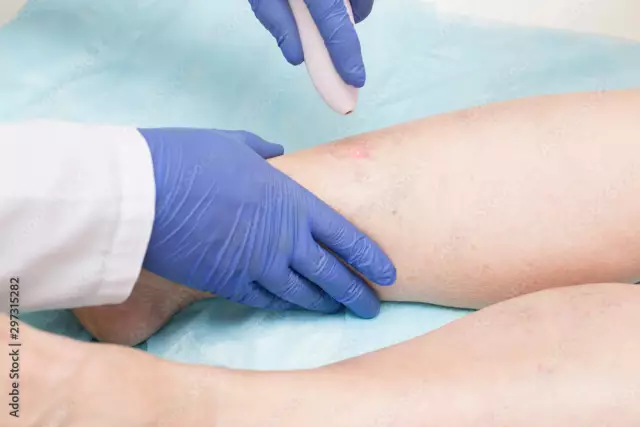- Author Rachel Wainwright [email protected].
- Public 2023-12-15 07:39.
- Last modified 2025-11-02 20:14.
Hemorrhoidal thrombosis: treatment, causes, diagnosis, possible complications
The content of the article:
- Why does hemorrhoid thrombosis occur?
- Disease symptoms
- The severity of thrombosis
- Complications of thrombosis
- Diagnosis of the disease
- Treatment of thrombosis of hemorrhoids
- Video
Hemorrhoidal thrombosis is one of the most dangerous complications of hemorrhoids. It is a blockage of a swollen hemorrhoidal vein with a dense coagulated blood clot. This causes hemodynamic disturbances in the damaged area and severe pain. The disease was assigned a code according to ICD 10 (international classification of diseases) K64 and a marker “hemorrhoids and perianal venous thrombosis”.

Thrombosis of the node with hemorrhoids is a serious complication that, in the absence of medical care, can lead to even more dangerous consequences.
Why does hemorrhoid thrombosis occur?
Thrombosis has many causes and can develop rapidly or be chronic. Acute thrombosis of hemorrhoids is characterized by a complex of symptoms that arise suddenly, they can be eliminated only by taking certain measures. The chronic course of the disease is fraught with the rapid progression of hemorrhoids to the next stages and circulatory disorders.
The causes of thrombosis include:
- trauma to the wall of the rectum or the hemorrhoid itself. Damage to the mucous membrane or vascular endothelium (the layer lining the veins and arteries) entails increased aggregation (gluing) of platelets, thickening of the blood clot. The denser the blood clot overlaps the lumen of the vessel, the more pronounced the clinical symptoms;
- a decrease in the speed of blood flow in the hemorrhoid. Venous congestion in the veins around the rectum does not promote active blood perfusion. It flows slowly, the shaped elements settle and form conglomerates. This is true for progressive hemorrhoids that do not receive treatment, when the patient continues to move a little, lead a predominantly sedentary lifestyle;
- increased blood pressure. It can develop both idiopathically, that is, for no apparent reason (more than 80% of people complain of high blood pressure), and when straining during constipation, lifting weights, and also due to increased intra-abdominal pressure during pregnancy.
Depending on which hemorrhoids are damaged, thrombosis of internal and external hemorrhoids is distinguished. They differ in diagnostic methods and approach to treatment, but both forms are equally dangerous to the patient's health.
When a clot is formed, the tissues around and along the clogged vessel experience a severe lack of nutrients. Before the blocking clot, blood accumulates, expands the walls of the veins and causes enlargement of the node and other symptoms.
Disease symptoms
The chronic form of thrombosis of the node may not appear for a very long time. For exacerbation and acute forms, the following symptoms are characteristic:
- sharp, piercing pain in the anal area. It occurs suddenly, is reflected in the perineum area, genitals. The pain syndrome does not depend on the time of bowel movement - this makes it possible to distinguish it from the ordinary visceral pulling pain in hemorrhoids;
- if the blood supply of the hemorrhoidal veins is high, then bleeding is likely. They appear spontaneously, the patient notices scarlet blood stains on his underwear. Can occur both during bowel movements and at any other time;
- swelling, hyperemia around the anus is a visual sign of thrombosis, one of the manifestations of thrombophlebitis is inflammation of the vein wall with a thrombus.
If an external node has undergone thrombosis, then its blood filling, cyanosis (cyanosis) due to the abundance of venous blood will also be a visible sign.
In the photo, thrombosis of hemorrhoids looks like a cyanotic venous plexus overflowing with blood around the anus.

The hemorrhoid with thrombosis fills with blood, becomes tense and sharply painful
The severity of thrombosis
The clinic distinguishes three stages of thrombosis of nodes, differing in organic changes in the affected tissues and, as a result, in treatment.
- There is spontaneous pain, the node is sharply painful when touched. Microcirculation is impaired, blood flow is slowed down. There are no inflammatory reactions yet, but treatment should be started immediately in order to avoid consequences.
- Hyperemia of the skin around the anus, swelling and inflammation, soreness of the perianal tissues. Due to the increase in the volume of the node, it can block the lumen of the rectum, causing obstruction and intestinal obstruction. Treatment consists in combination therapy with anti-inflammatory, analgesic, blood circulation-improving agents.
- Massive ischemia, cyanosis of tissues around the anus. The possibility of developing necrosis of the surrounding tissues and subcutaneous fatty tissue, purulent inflammatory processes. The nodes look like dense, dark, penetrated by the vessels of the formation. The vessels in the affected area will no longer return to their previous functions, they have collapsed and degenerated. The condition is accompanied by intense pain, fetid odor. Surgical intervention is indicated.
Thrombosis can occur as early as the second stage of hemorrhoids. Infringement of the node greatly accelerates the decay processes in ischemic tissues. Internal hemorrhoids are characterized by better nutrition from the microvasculature, therefore, thrombosis of the internal node passes more slowly from one severity to another. Thrombosis of the external hemorrhoidal node is characterized by a rapid increase in symptoms.
Complications of thrombosis
The most dangerous complication is necrosis of the affected area. This is irreversible tissue necrosis due to an acute lack of nutrients. The zone of necrosis is rapidly expanding, so the condition requires immediate treatment. Treatment in this case is surgical, consisting in the complete excision of necrotic tissue, which can represent a fairly large part of the perianal region and rectum. The efforts of doctors in thrombosis are aimed at preventing the development of necrosis, and if it has already developed, to prevent its spread.
There is a small likelihood of a thrombus tearing off in thrombosis of internal nodes, which is practically excluded in the external form of the disease. When a fibrin clot enters the bloodstream, it can clog vessels of medium and small caliber, eliminating local trophic disorders, circulatory disorders.
Development of ulceration and paraproctitis is possible. The mucous membrane covered with trophic ulcers does not heal well, and the pus of pi paraproctitis quickly spreads along the loose connective tissue, creating anal fistulas.
Diagnosis of the disease
To diagnose and treat hemorrhoidal vein thrombosis, you should contact a proctologist or surgeon without delay, immediately after the first signs appear. The chronic form is often found during a regular examination, which patients with hemorrhoids should be scheduled every six months.
During the examination, the doctor, as a rule, immediately establishes a diagnosis of venous thrombosis of the hemorrhoidal plexus, relying on external signs and increased soreness of the perianal region. On examination, he assesses the color of the skin and mucous membranes, hyperemia, swelling. A finger examination allows you to determine the increased density and soreness of the nodes.
If necessary, resort to additional studies - examination using a rectal speculum with a dilator, angiography with contrast and laboratory diagnostics.
It is important not only to identify thrombosis, but also to determine its stage, since the tactics of treatment depend on this - in the early stages it is conservative and is carried out with the help of pharmacological agents, in the later stages an operation is indicated.
Treatment of thrombosis of hemorrhoids
Conservative treatment is carried out in two directions: etiotropic (eliminating the cause of thrombosis) and symptomatic (alleviating the patient's suffering, improving his general condition). The drugs of the following groups are used:
- pain relievers - they are applied locally already at the examination stage, since often palpation of hemorrhoids is difficult due to severe pain. Later, they can be prescribed in the form of drugs of systemic action;
- anti - inflammatory - reduce tissue damage by inflammatory agents, relieve pain and swelling. The bioavailability of drugs in the focus of inflammation is ensured by local drugs - rectal suppositories (suppositories), ointments, microclysters;
- fibrinolytics (drugs that reduce blood viscosity) - are necessary to liquefy a dense clot and normalize blood circulation;
- phlebotonics - improve the tone of the veins, helps to reduce venous stasis;
- angioprotectors - protect the inner lining of blood vessels from damage, preventing the appearance of new blood clots;
- antispasmodics - relax the muscular membrane of blood vessels and sphincters, prevent pinching of the node and eliminate discomfort;
- drugs that improve the functions of the gastrointestinal tract (motility stimulants, laxatives) - are prescribed as supportive therapy, facilitate defecation, prevent tissue injury by dense feces.
With proper treatment, the thrombus dissolves, blood circulation is normalized - perianal thrombosis quickly disappears as soon as its immediate cause is eliminated. Conservative treatment does not require hospitalization; it can also be carried out at home.
In cases where conservative therapy is ineffective, they resort to surgical intervention. It consists in removing the hemorrhoid along with the surrounding tissues and supplying vessels. The volume depends on the scale of the lesion - it can be a small operation performed under local anesthesia on an outpatient basis, or a large-scale intervention with excision of a large amount of tissue.

Thrombosis of the node at a late stage requires surgical treatment, the purpose of which is to prevent the development of necrosis
With the Milligan-Morgan operation for excision of hemorrhoids, a long recovery period follows. Operation according to the Longo method is less traumatic, but requires special equipment, materials and high qualifications of the surgeon. It has high efficiency, a shorter rehabilitation period and excellent reviews from both doctors and patients.
After recovery, the patient must adhere to the basic rules of prevention: follow a diet, give up excessive physical exertion, lifting weights, a sedentary lifestyle. Otherwise, a relapse of the disease is not excluded.
Video
We offer for viewing a video on the topic of the article.

Nikita Gaidukov About the author
Education: 4th year student of the Faculty of Medicine No. 1, specializing in General Medicine, Vinnitsa National Medical University. N. I. Pirogov.
Work experience: Nurse of the cardiology department of the Tyachiv Regional Hospital No. 1, geneticist / molecular biologist in the Polymerase Chain Reaction Laboratory at VNMU named after N. I. Pirogov.
Found a mistake in the text? Select it and press Ctrl + Enter.






